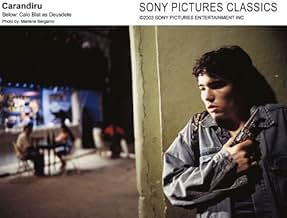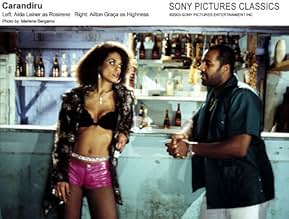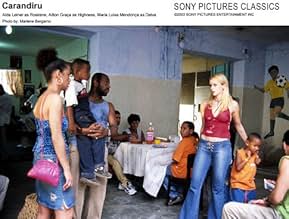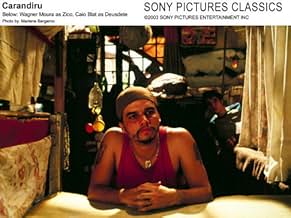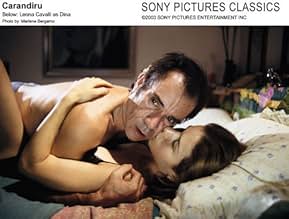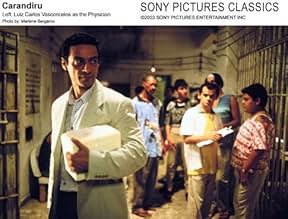Aggiungi una trama nella tua linguaStories of crime, revenge, love, and friendship at the Carandiru Penitentiary, the largest prison in Latin America.Stories of crime, revenge, love, and friendship at the Carandiru Penitentiary, the largest prison in Latin America.Stories of crime, revenge, love, and friendship at the Carandiru Penitentiary, the largest prison in Latin America.
- Regia
- Sceneggiatura
- Star
- Premi
- 16 vittorie e 33 candidature totali
- Gilson
- (as Enrique Díaz)
- Rosirene
- (as Aída Leiner)
Recensioni in evidenza
However, this is not the non-stop assault on the senses of grim violence you might expect. In fact, only the last twenty minutes or so of the film deal with the massacre at all and the film instead concentrates on a much more human aspect to the carnage. Focusing on the character of the Doctor as he tries to raise awareness of AIDs in the prison, it revolves around his day to day life as he chats casually with the inmates, learning of their hopes, fears and more often than not, their reason for being in the prison in the first place. These are stories that range from sad, to touching to outright hilarity and you soon find yourself absorbed in this world of offbeat criminals, so much so that when the violence does erupt, it is all the more shocking for it.
There are differences to the normal, US prison drama as well. I'm not sure how the Brazilians run their penitentiaries, but here there are no uniforms and they are allowed many of the comforts of home, along with free reign of the prison yard. But these are still drab conditions, with multiple inmates crammed into a single room, sweltering in the intense heat of the tropical summer. And ultimately, the prison is a community, made of genuine individuals, rather than clear cut prison stereotypes. This is a masterful film, one of my top movies of all time.
Festival. Let me tell you, my day was full of carnage but it's OK because both movies were very good. The director was there as well as an actor or two if I remember correctly, they spoke about the film with true passion which added to the essence of the final product. It opend my eyes to an event that I never knew of. Highness was a great charater, Graca was my favorite, he should learn
english and get into the indie scene in North America. Good film 7\10.
Lo sapevi?
- QuizDr. Dráuzio Varella wrote the original book at the encouragement of a patient he was treating for lymphatic cancer. That very patient happened to be Hector Babenco, who recovered and went on to direct the film adaptation.
- BlooperDuring the riot, as the inmates are running up the stairs of the cell block shortly after the riot squad has entered, one inmate can be seen wearing a T-Shirt of hip-hop group the Wu-Tang Clan. The group only formed in the year the riot took place (1992), and did not release their first widely available album (36 Chambers - Enter the Wu-Tang) until the following year. It is unlikely they would at this time have had a following in Brazil, nor would merchandise be available.
- Citazioni
Lady Di: I've come to take the test.
Médico - Physician: Please, take a seat. First, I'd like to ask you a few questions, Lady Di.
Lady Di: I've seen this movie before, doctor. I've never needed a blood transfusion and I never pierce my veins. The only drug I use is a joint now and then... when I watch TV or for a little romance.
Médico - Physician: And partners, how many?
Lady Di: Oh, about 2000.
- ConnessioniFeatured in 2005 Glitter Awards (2005)
I più visti
- How long is Carandiru?Powered by Alexa
Dettagli
- Data di uscita
- Paesi di origine
- Sito ufficiale
- Lingua
- Celebre anche come
- Vzbura vo väznici Carandiru
- Luoghi delle riprese
- Aziende produttrici
- Vedi altri crediti dell’azienda su IMDbPro
Botteghino
- Budget
- 12.000.000 BRL (previsto)
- Lordo Stati Uniti e Canada
- 216.335 USD
- Fine settimana di apertura Stati Uniti e Canada
- 17.945 USD
- 16 mag 2004
- Lordo in tutto il mondo
- 10.781.635 USD
- Tempo di esecuzione2 ore 25 minuti
- Colore
- Mix di suoni
- Proporzioni
- 1.85 : 1
Contribuisci a questa pagina








